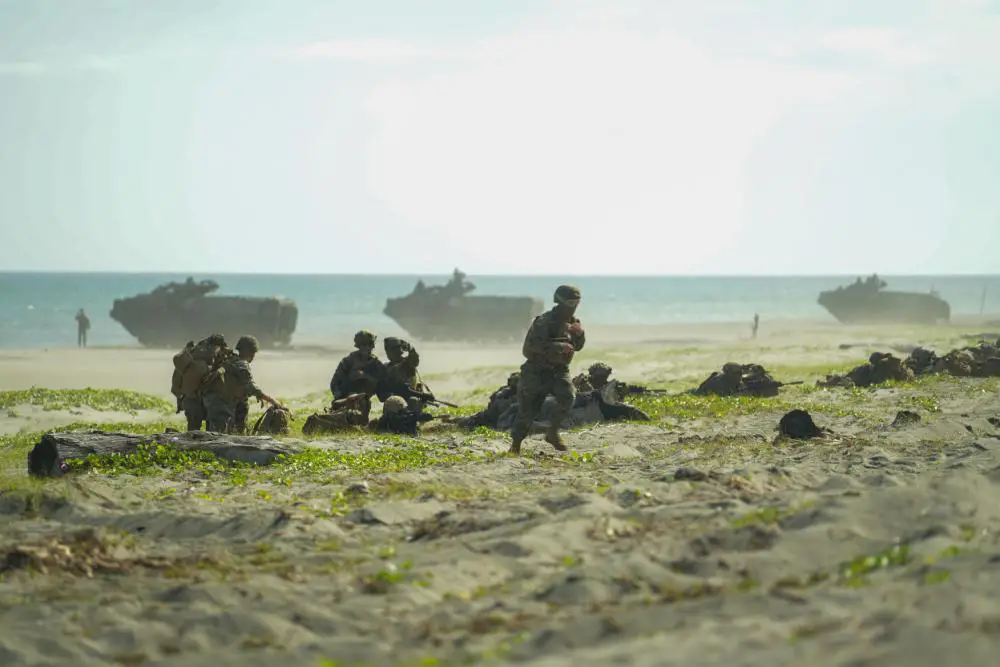The 3d Marine Littoral Regiment (MLR) Headquarters (HQ) conducted its inaugural deployment in the first island chain, working shoulder-to-shoulder with the Armed Forces of the Philippines (AFP) during exercise Balikatan 22, which is scheduled to run from March 28 to April 8, 2022. BK22 is the 37th iteration of the Philippine-led bilateral exercise, which is designed to bolster the collective security and defensive capabilities of the alliance. For the Marines and Sailors of 3d MLR, the exercise commenced with combined amphibious landings in northern Luzon followed by coastal defense training, providing the newly redesignated unit with a valuable opportunity to deploy from Hawaii into the western Pacific to work alongside the Philippine Marine Corps (PMC) and other AFP counterparts. Upon arrival in the Philippines, the 3d MLR HQ linked up with 1st Battalion, 3d Marines to integrate into the exercise with the PMC while pursuing Force Design 2030 experimentation.

The 3d MLR’s logistics and ability to command and control (C2) were tested throughout the exercise as it established distributed and small expeditionary sites in austere environments. The Marines developed creative solutions to address the inherent challenges of operating in such locations. Conducting novel methods for expeditionary sustainment, the 3d MLR worked with elements of the AFP and 3d Marine Logistics Group to achieve effective solutions. Marines and Sailors with Combat Logistics Regiment 3 and 9th Engineer Support Battalion were critical to this success. CLR-3 served as the Marine Air-Ground Task Force command element, providing operational contracting support, and supported reception, staging, onward movement, and integration for all Marine forces. 9th ESB served as the logistics combat element, providing sustainment, littoral engineering reconnaissance, and geospatial imagery support with the VAPOR 55 unmanned aerial system.

Marines and Sailors from Alpha Surgical Company and Bravo Surgical Company, 3d Medical Battalion, and Combat Logistics Regiment 37 teamed up to establish a robust Role II medical facility at the Cagayan International Airport during BK22. In addition to elements from the 1st Battalion, 3d Marines, elements of the 3d Littoral Anti-Air Battalion and the 3d MLR Communication Company deployed to support distributed C2, experimentation with emerging capabilities and concepts, and strengthen partnerships and security within the region. Experimentation with sensors, fire support, and expeditionary advanced bases (EABs) provided the framework for an integrated coastal defense with the AFP. Over eight days, the 3d MLR HQ partnered with the Philippine Marine Corps Coastal Defense Regiment and provided command and control over multiple EABs across northern Luzon. This coastal defense was further enhanced by two Patriot Missile Batteries from the U.S. Army’s 1st Battalion, 1st Air Defense Artillery Regiment. The U.S. Navy also played a key role with divers, ship-to-shore connectors, and sealift from the USS Ashland (LSD 48).

A platoon of High Mobility Artillery Rocket Systems from 3d Battalion, 12th Marines also integrated into the coastal defense. The HIMARS platoon received real-time targeting data from the 3d Marine Littoral Regiment combat operations center to prosecute simulated fire missions during the training. The HIMARS provided a ground-based precision fires capability in support of counter-landing operations and served as a surrogate for the future employment of the Navy-Marine Expeditionary Ship Interdiction System. The coastal defense scenario enabled the 3d MLR fires and intelligence sections to integrate with the joint network of sensors and develop a clear common operational picture. At the same time, a small element of the 3d Littoral Anti-Air Battalion assisted with the de-confliction of land, air, and maritime traffic to ensure a safe flight path for the simulated missile. This combined interoperability event brought the U.S. Marine Corps and Philippine Marine Corps together with a shared mission to bolster the collective defensive capabilities of the alliance.

The Marine Corps Warfighting Laboratory observed III Marine Expeditionary Force (MEF) forces during BK22 to observe and assess a range of activities necessary to conduct joint and combined littoral operations with our Philippine partners. Although the 3d MLR is not planned to be fully operational for several years, BK22 provided many lessons learned and opportunities to strengthen critical relationships with the Philippine Marine Corps and joint partners while expanding the collective defensive capabilities of the U.S.-Philippine alliance. The MLR will command and control three subordinate battalions: a Littoral Combat Team, Littoral Anti-Air Battalion, and Combat Logistics Battalion. The MLR will exercise command and control over these units via a robust regimental headquarters and communications company with enhanced signals and human intelligence, reconnaissance, communications, logistics planning, civil affairs, cyber, and information operations capabilities. Each of the elements of the MLR will be capable of training and operating with our allies and partners.















